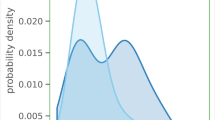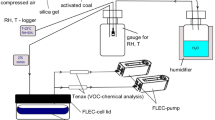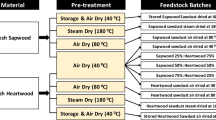Abstract
Large amounts of sawdust are dried to produce particleboard and pellets. During drying and densification, volatile organic compounds are emitted. These may contribute to the formation of tropospheric ozone. In this study, sesquiterpene emissions from Norway spruce sawdust dried in a continuous spouted bed at 140–200 °C have been investigated, and patterns of co-variation between sesquiterpene emissions and drying parameters have been elucidated. For sawdust dried to moisture contents suitable for pellets production, about 10–20 mg sesquiterpenes were emitted per kg oven dry sawdust. The sesquiterpene emissions amounted to about 20% of the monoterpene emissions. Drying at 200 °C caused markedly larger sesquiterpene emissions than did drying at 140 or 170 °C. The sesquiterpene emissions increased considerably at low wood moisture contents. While it has long been known that monoterpenes are emitted during the processing of wood, this study shows that sesquiterpenes are of considerable importance too.
Zusammenfassung
Für die Spanplatten- und Pelletsproduktion werden große Mengen an Sägemehl getrocknet. Beim Trocknen und Verdichten werden flüchtige organische Verbindungen (VOC) abgegeben, die zur Bildung von tropospherischem Ozon beitragen können. In dieser Studie wurden Sesquiterpenemissionen beim Trocknen von Fichtensägemehl in einem Wirbelstoßtrockner bei 140–200 °C untersucht. Dabei wurden Kovarianzmuster zwischen Sesquiterpenemissionen und Trocknungsparametern bestimmt. Beim Trocknen von Sägemehl auf eine für die Herstellung von Pellets benötigte Holzfeuchte wurden ungefähr 10–20 mg Sesquiterpene pro kg darrtrockenem Sägemehl emittiert. Die Sesquiterpenemissionen machten ca. 20% der Monoterpenemissionen aus. Bei einer Trocknung bei 200 °C sind die Sesquiterpenemissionen wesentlich höher als bei einer Trocknung bei 140 bzw. 170 °C. Bei niedriger Holzfeuchte nahmen die Sesquiterpenemissionen erheblich zu. Während die Monoterpenemissionen bei der Holzverarbeitung bereits seit langem bekannt sind, wird in dieser Studie gezeigt, dass auch die Sesquiterpene von großer Bedeutung sind.
Similar content being viewed by others
References
Altshuller AP (1983) Review: natural volatile organic substances and their effect on air quality in the United States. Atmos Environ A 17(11):2131–2165
Back EL (2002) Pattern of parenchyma and canal resin composition in softwoods and hardwoods. J Wood Sci 48(3):167–170
Banerjee S (2001) Mechanisms of terpene release during sawdust and flake drying. Holzforschung 55(4):413–416
Banerjee S, Hutten M, Su W, Otwell L, Newton L (1995) Release of water and volatile organics from wood drying. Environ Sci Technol 29(4):1135–1136
Banerjee S, Pendyala K, Buchanan M, Yang RM, Abu-Daabes M, Otwell LPE (2006) Process-based control of HAPs emissions from drying wood flakes. Environ Sci Technol 40(7):2438–2441
Banerjee S, Su W, Wild MP, Otwell LP, Hittmeier ME, Nichols KM (1998) Wet line extension reduces VOCs from softwood drying. Environ Sci Technol 32(9):1303–1307
Berghel J, Renstrom R (2004) Controllability of product moisture content when nonscreened sawdust is dried in a spouted bed. Dry Technol 22(3):507–519
CMAS (2007) The Community Multi-scale Air Quality (CMAQ) modeling system. version 4.7. http://www.cmaq-model.org/, accessed Dec 2008. (CMAQ is an open-source project of the US EPA, supported and distributed by the Community Modeling and Analysis System (CMAS) center at the University of North Carolina, USA)
Conners TE, Yan H, Banerjee S (2002) Mechanism of VOC release from high-temperature southern pine lumber drying. Wood Fiber Sci 34(4):666–669
Danielsson S, Rasmuson A (2002) The influence of drying medium, temperature, and time on the release of monoterpenes during convective drying of wood chips. Dry Technol 20(7):1427–1444
Durkee JB (2008) C4: Critical Cleaning For Contamination Control: VOC Management – EPA’s Dual System. Controlled Environments Magazine
Englund F, Nussbaum RM (2000) Monoterpenes in Scots pine and Norway spruce and their emission during kiln drying. Holzforschung 54(5):449–456
ENVIRON (2005) The Comprehensive Air quality Model (CAMx). version 4.50. http://www.camx.com, accessed Dec 2008. (CAMx is a publicly available open-source computer modeling system for the integrated assessment of gaseous and particulate air pollution)
EU (2001) Directive 2001/81/EC on National Emission Ceilings for certain atmospheric pollutants. Available at: http://europa.eu/scadplus/leg/en/lvb/l28095.htm (accessed Dec 2008).
Felzer BS, Cronin T, Reilly JM, Melilloa JM, Wang XD (2007) Impacts of ozone on trees and crops. Comptes Rendus Geosci 339(11–12):784–798
Folinsbee LJ (1981) Effects of ozone exposure on lung-function in man – a review. Rev Environ Health 3(3):211–240
Granström KM (2003a) Emissions of monoterpenes and VOCs during drying of sawdust in a spouted bed. For Prod J 53(10):48–55
Granström KM (2003b) A method to measure emissions from dryers with diffuse leakages, using evaporated water as a tracer. Dry Technol 21(7):1197–1214
Granström KM (2005) A method to measure emissions from dryers with diffuse leakages 2 – Sensitivity studies. Dry Technol 23(5):1127–1140
Hagström K, Axelsson S, Arvidsson H, Bryngelsson IL, Lundholm C, Eriksson K (2008) Exposure to wood dust, resin acids, and volatile organic compounds during production of wood pellets. J Occupat Environ Hyg 5(5):296–304
Hedenstierna G, Alexandersson R, Wimander K, Rosen G (1983) Exposure to terpenes – Effects on pulmonary-function. Int Arch Occupat Environ Health 51(3):191–198
Ingram LL, Shmulsky R, Dalton AT, Taylor FW, Templeton MC (2000) The measurement of volatile organic emissions from drying southern pine lumber in a laboratory-scale kiln. For Prod J 50(4):91–94
Johansson A, Rasmuson A (1998) The release of monoterpenes during convective drying of wood chips. Dry Technol 16(7):1395–1428
Jonsson A, Hillring B (2006) Planning for increased bioenergy use – Evaluating the impact on local air quality. Biomass Bioenerg 30(6):543–554
Kaltschmitt M, Weber M (2006) Markets for solid biofuels within the EU-15. Biomass Bioenerg 30(11):897–907
Kampa M, Castanas E (2008) Human health effects of air pollution. Environ Pollut 151(2):362–367
Lehtikangas P (2000) Storage effects on pelletised sawdust, logging residues and bark. Biomass Bioenerg 19(5):287–293
Milota MR (2000) Emissions from wood drying – The science and the issues. For Prod J 50(6):10–20
Otwell LP, Hittmeier ME, Hooda U, Yan H, Su W, Banerjee S (2000) HAPs release from wood drying. Environ Sci Technol 34(11):2280–2283
Pun BK, Seigneur C, Kristen L (2006) Modeling secondary organic aerosol formation via multiphase partitioning with molecular data. Environ Sci Tech 40(15):4722–4731
Rupar K, Sanati M (2003) The release of organic compounds during biomass drying depends upon the feedstock and/or altering drying heating medium. Biomass Bioenerg 25(6):615–622
Sillman S (1999) The relation between ozone, NOx and hydrocarbons in urban and polluted rural environments. Atmos Environ 33(12):1821–1845
Strömvall AM, Petersson G (2000) Volatile terpenes emitted to air. In: Allen LH, Back EL (eds) Pitch control, wood resin and deresination, Tappi Press, Atlanta, USA, pp 77–99
Ståhl M, Granström K, Berghel J, Renström R (2004) Industrial processes for biomass drying and their effects on the quality properties of wood pellets. Biomass Bioenerg 27(6):621–628
UNECE (1991) The 1979 Convention on Long-Range Transboundary Air Pollution (LRTAP) – The 1991 Protocol concerning the Control of Emissions of Volatile Organic Compounds or their Transboundary Fluxes. Available at http://www.unece.org/env/lrtap/ (accessed Dec 2008).
Wahlund B, Yan J, Westermark M (2004) Increasing biomass utilisation in energy systems: A comparative study of CO2 reduction and cost for different bioenergy processing options. Biomass Bioenerg 26(6):531–544
Welling I, Mielo T, Raisanen J, Hyvarinen M, Liukkonen T, Nurkka T, Lonka P, Rosenberg C, Peltonen Y, Svedberg U, Jappinen P (2001) Characterization and control of terpene emissions in Finnish sawmills. Am Ind Hyg Assoc J 62(2):172–175
Yokouchi Y, Ambe Y (1985) Aerosols Formed from the Chemical-Reaction of Monoterpenes and Ozone. Atmos Environ 19(8):1271–1276
Author information
Authors and Affiliations
Corresponding author
Rights and permissions
About this article
Cite this article
Granström, K.M. Emissions of sesquiterpenes from spruce sawdust during drying . Eur. J. Wood Prod. 67, 343–350 (2009). https://doi.org/10.1007/s00107-009-0325-1
Received:
Published:
Issue Date:
DOI: https://doi.org/10.1007/s00107-009-0325-1




